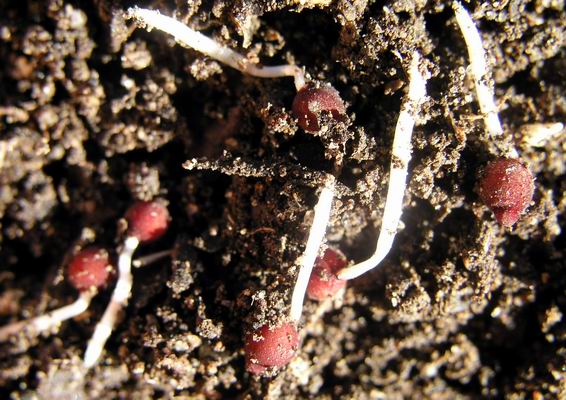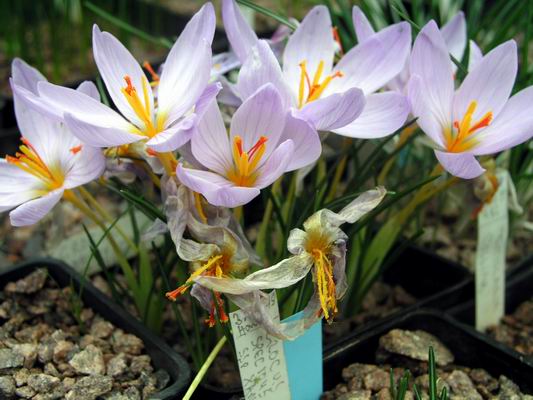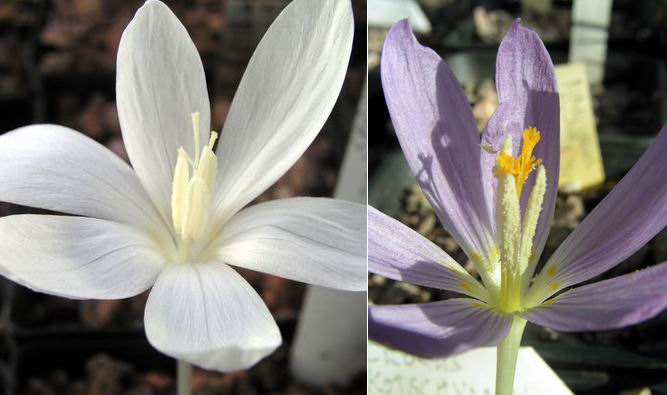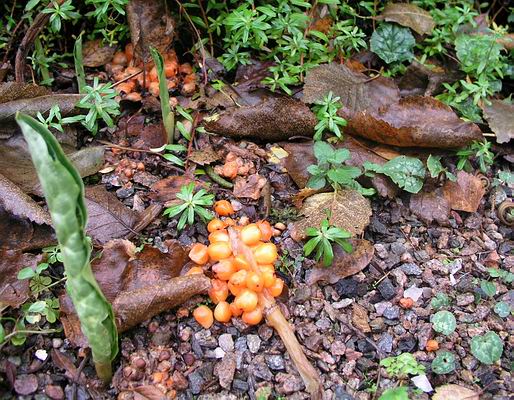|
BULB LOG 45 -- 3rd November 2004

Crocus boryi x2
It is still our crocus that are providing most of the flowering interest just now, with this Crocus boryi looking nice in the brief period of sunshine that we enjoyed.
You may remember the Crocus boryi 'imposter' that appeared in logs 39 and 40. There was quite a lot of discussion as to what it might be both in the log and the forum. I was awaiting the opportunity to see the corms which might provide the answer.

Crocus imposter
Now that the flowers have passed I was able to carefully tip it out of its pot to photograph the corms. The corms would indicate that it is more likely to be a form of pulchellus than boryi, but it is very different to our other white forms of pulchellus and I am not confident with any name yet. All this shows that we must continually question the names that we get plants under, by reading books, searching the internet and discussing them with other enthusiasts, preferably on the SRGC forum!

Crocus seed germinating
As I tipped the pot out I had to watch for the seed that I sowed with the corms when they were repotted in the summer. They were sown at depth, just on top of the corms, and here they are just starting to germinate. Crocus seeds perform best when sown at least 5cms down in the compost.

Pollinating crocus
While I am on the subject of seed, it is important to make sure that your flowers have been pollinated. At this time of year there are not always enough insects around so I transfer pollen from style to stigma several times on the days the flower is open to give me the best chance of having a good crop of ripe seed next June.

Crocus laevigatus
One of my favourite of the autumn flowering species is Crocus laevigatus; it is easy to grow. It will flower in three years from seed and you will get considerable variation in the markings and the colour.

Crocus longiflorus
One of the problems with our climate is the cold damp days that we can get at any time of year. This can very quickly turn the newly fading crocus flowers into a wet soggy mass which can become infected with moulds that may descend to the corm if you are not careful. Once that flower falls over and starts to wither the fertilised pollen will have grown down the tube into the ovary so you can remove the spent flower with a sharp upward tug. Good housekeeping of this type is an essential part of keeping your autumn flowering bulbs healthy.

Crocus ochroleucus albus
An interesting form of Crocus ochroleucus, it is almost pure white with only a few yellow spots at the base of each petal, it is closely related to C. kotschyana as seen in the next picture.

Crocus ochroleucus albus & kotschyanus

Chewed crocus leaves
All the fresh young bulb leaves that are emerging are like a high class delicatessen to the slug population. A slug or snail can do a lot of damage in a single night so be on the look out. I apply slug pellets sparing to the bulb frames making sure that I collected any infected slugs on a daily basis.

Arum fruits
This is a very autumnal scene in one of the bulb beds with young Arum leaves appearing as their fruits still lie uncollected on the ground. I have often wondered what distributes the Arum and Arisaema seeds as I have never noticed them being eaten or collected in our garden - they must be bright red to attract something but what?

Tropaeolum azureum
Our big plant of Tropaeolum azureum is more advanced than normal this year. Also for the first time ever there are three stems coming through the gravel top dressing. Is this because the stem has branched underground or have we now got three growth points on the tuber, and if we have will the tuber now divide?

Crocus banaticus x2
Two lots of Crocus banaticus: one is going over and the other one is just coming out. This is one of the many advantages of raising plants from seed - they will give you a longer flowering season as they do not all flower at exactly the same time.
^ back to the top ^
|

